The Multi-Cloud SDN Market is estimated to be valued at USD 6.3 billion in 2025 and is projected to reach USD 19.8 billion by 2035, registering a compound annual growth rate (CAGR) of 12.2% over the forecast period.
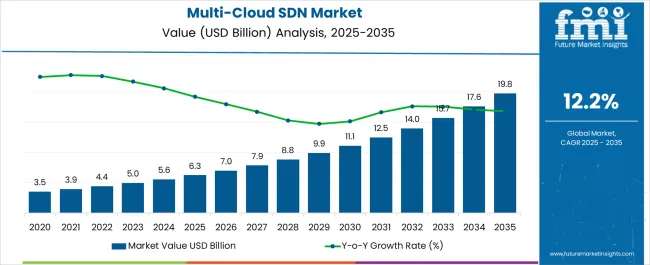
| Metric | Value |
|---|---|
| Multi-Cloud SDN Market Estimated Value in (2025E) | USD 6.3 billion |
| Multi-Cloud SDN Market Forecast Value in (2035F) | USD 19.8 billion |
| Forecast CAGR (2025 to 2035) | 12.2% |
The multi cloud SDN market is witnessing accelerated growth driven by enterprises prioritizing flexible cloud strategies, network agility, and security in increasingly hybrid IT environments. The rising adoption of cloud native applications and data intensive workloads has created strong demand for centralized management and automated provisioning across multiple cloud platforms.
Advancements in virtualization, API based integration, and AI enabled orchestration have strengthened the performance and scalability of SDN solutions. Furthermore, compliance requirements and rising cyber threats have pushed organizations to embrace software defined models that provide visibility and control across complex infrastructures.
Vendors are focusing on inter operability and seamless workload mobility to support enterprises managing diverse cloud ecosystems. The outlook remains robust as enterprises pursue cost optimization, operational resilience, and agility, positioning multi cloud SDN as a cornerstone of next generation network management strategies.
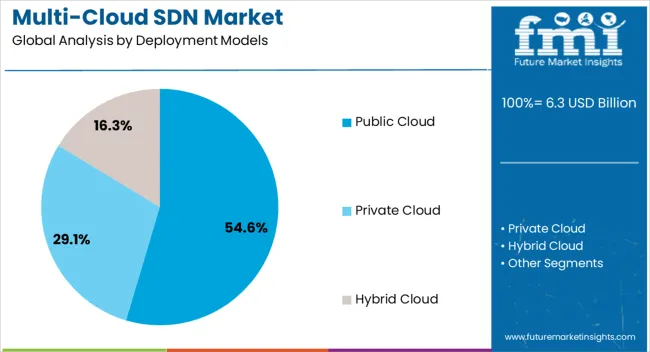
The public cloud deployment model is projected to hold 54.60% of the total market revenue by 2025, making it the leading segment. Its dominance is driven by the need for cost efficiency, scalability, and global accessibility.
Organizations have favored public cloud based SDN solutions to achieve faster deployment cycles, on demand resource allocation, and reduced capital expenditure. The ability to integrate seamlessly with multiple cloud service providers has further strengthened its adoption.
Additionally, public cloud SDN platforms provide advanced security frameworks, compliance tools, and continuous updates, ensuring adaptability to evolving enterprise requirements. These benefits have reinforced the position of public cloud as the dominant deployment model in the multi cloud SDN market.
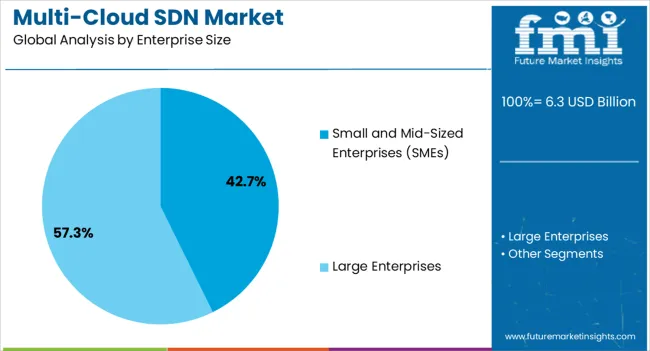
The small and mid sized enterprises segment is expected to account for 42.70% of overall market revenue by 2025, establishing it as the leading enterprise size category. Growth in this segment is being supported by the increasing need among SMEs to optimize costs, scale IT resources quickly, and compete with larger players through technology adoption.
Cloud based SDN solutions have provided SMEs with the ability to manage complex networks with limited internal expertise while ensuring flexibility and security. The availability of subscription based pricing and managed services has lowered barriers to entry, encouraging widespread uptake.
As SMEs continue to prioritize agility and digital transformation, their reliance on multi cloud SDN solutions is expected to remain strong, positioning this segment at the forefront of market expansion.
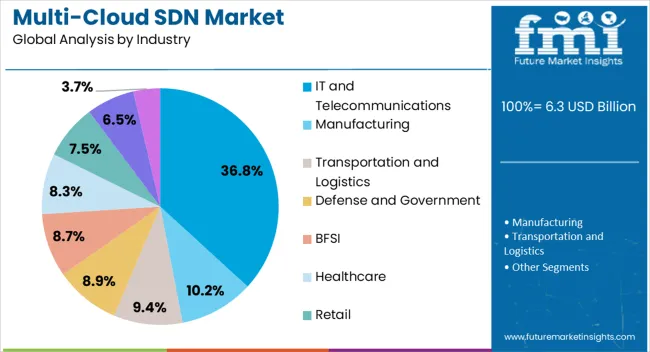
The IT and telecommunications industry is projected to represent 36.80% of total market revenue by 2025 within the industry category, marking it as the most prominent segment. This is being propelled by increasing data traffic, rising adoption of cloud based services, and the demand for high performance networks.
IT and telecom operators have leveraged multi cloud SDN to support dynamic network management, low latency services, and efficient bandwidth utilization. The technology has been instrumental in enabling telecom firms to deploy 5G networks, manage edge computing infrastructure, and improve service reliability.
Additionally, the need for seamless connectivity across multiple platforms has reinforced its adoption. Consequently, IT and telecommunications continue to dominate the industry category by driving large scale integration of multi cloud SDN solutions.
Multi-Cloud SDN (FMC) market is expected to grow at a high CAGR of 12% from 2025 to 2035 and is projected to reach USD 19.8 Billion by 2035. A multi-cloud SDN approach enables users to make seamless cloud-to-cloud connections over a low-latency direct connection that bypasses the public internet for offering enhanced security. SDN architectures make it much easier to build a functional multi-cloud environment through a single platform.
As organizations are continuously focusing towards scaling their hybrid cloud environments, it has become very critical to leverage solutions that help improve productivity and processes. Since, the inception of SDN, the technology has got more attention among enterprises. As more organizations have adopted hybrid cloud and tasked their network engineers with figuring out the basics of connectivity, reliability, and security.
As SDN platforms are enhanced to support multi-cloud environments, the platforms are being used to mitigate the inherent complexity of establishing and maintaining network and security policies across hybrid IT landscapes.
Also, the platform delivers better application experience, reduce security risks and lower operations cost for multi-cloud applications. Thus, the benefits of cost-effectiveness, high scalability, and reliability offered by multi-cloud SDN is expected to propel the market growth in coming years.
Software-Defined Networking (SDN) and cloud computing complement each other and enable new visibility and control over the networks. SDNs became even more valuable, when it became possible to integrate the architecture easily with cloud-based environments.
The convergence of both the technologies let users to respond quickly to changes. SDN manages network configuration more efficient and improves network performance and monitoring.
SDNs have become integral to cloud-based IT infrastructure. Both enterprises and public cloud providers have started leveraging SDNs in their cloud environments, as applications can self-define the network requirements directly from the application itself. Thus, the network can support hundreds of configurations and be optimized for specific workloads 100% of the time.
Today, SDN architecture can better understand the cloud environment it operates in. That enables new kinds of flexibility, speed, and innovation. In fact, big players present in the SDN market like Cisco, Juniper and VMware have all made moves to tie together enterprise data center and cloud worlds.

When it comes to cloud computing adoption, USA is the most mature market. This is due to the early adoption of cloud based networks by the USA markets. Organizations in both the countries have taken high level of initiatives towards adoption of latest digital technologies.
The high internet penetration, coupled with initiatives from government agencies moving partially to the cloud to improve information services would also drive the growth of multi-cloud SDN technologies in the USA & Canada.
USA is expected to hold the largest share in the North America Multi-Cloud SDN market. The country has always been at the forefront in terms of technological development. Moreover, USA is home to multiple multi-cloud SDN solution vendors, such as Cisco Systems, Oracle, Juniper Networks, Fortinet, Ciena Corporation, HPE, Dell and among others.
These companies are targeting higher revenue and business expansions due to high competition and demand prevailing across the region.
China is the world's second-largest cloud computing market. The market is prominently occupied by Alibaba Cloud. Alibaba is the largest provider of cloud services in China. The company is the fourth largest global Infrastructure-as-a-Service provider following AWS, Azure, and Google Cloud Platform.
The integration of cloud computing services in for industrial transformation is one of the most prominent trends, in China. It is estimated that in China, the cloud computing industry has been growing around to 25-30% each year, from last five years, and the trend will likely continue into the near future.
Moreover, enterprises in China are adopting the latest technologies to sustain in the global market competition. Government policies in China are also promoting the adoption of cloud services in multiple sectors. These factors are expected to propel the growth of multi-cloud SDN market in China.
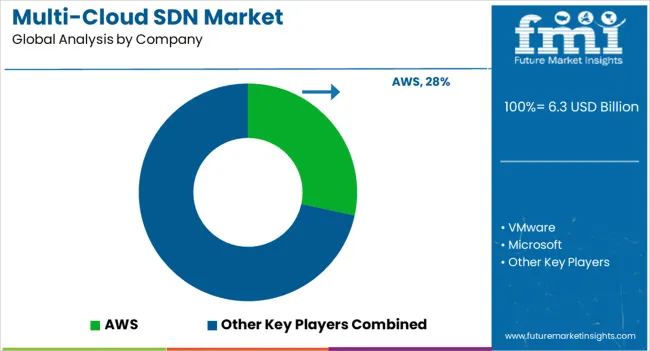
Some of the leading vendors offering Multi-Cloud SDN products include
These vendors have adopted various key strategies, to increase their market shares locally and globally. The vendors are focusing on product innovation and strategic partnerships with the regional vendors to collaborate for offering advanced solutions to effectively manage business operations.
The report is a compilation of first-hand information, qualitative and quantitative assessment by industry analysts, inputs from industry experts and industry participants across the value chain. The report provides in-depth analysis of parent market trends, macro-economic indicators and governing factors along with market attractiveness as per segments.
The report also maps the qualitative impact of various market factors on market segments and geographies.
The global multi-cloud SDN market is estimated to be valued at USD 6.3 billion in 2025.
The market size for the multi-cloud SDN market is projected to reach USD 19.8 billion by 2035.
The multi-cloud SDN market is expected to grow at a 12.2% CAGR between 2025 and 2035.
The key product types in multi-cloud SDN market are .
In terms of enterprise size, small and mid-sized enterprises (smes) segment to command 42.7% share in the multi-cloud SDN market in 2025.






Our Research Products

The "Full Research Suite" delivers actionable market intel, deep dives on markets or technologies, so clients act faster, cut risk, and unlock growth.

The Leaderboard benchmarks and ranks top vendors, classifying them as Established Leaders, Leading Challengers, or Disruptors & Challengers.

Locates where complements amplify value and substitutes erode it, forecasting net impact by horizon

We deliver granular, decision-grade intel: market sizing, 5-year forecasts, pricing, adoption, usage, revenue, and operational KPIs—plus competitor tracking, regulation, and value chains—across 60 countries broadly.

Spot the shifts before they hit your P&L. We track inflection points, adoption curves, pricing moves, and ecosystem plays to show where demand is heading, why it is changing, and what to do next across high-growth markets and disruptive tech

Real-time reads of user behavior. We track shifting priorities, perceptions of today’s and next-gen services, and provider experience, then pace how fast tech moves from trial to adoption, blending buyer, consumer, and channel inputs with social signals (#WhySwitch, #UX).

Partner with our analyst team to build a custom report designed around your business priorities. From analysing market trends to assessing competitors or crafting bespoke datasets, we tailor insights to your needs.
Supplier Intelligence
Discovery & Profiling
Capacity & Footprint
Performance & Risk
Compliance & Governance
Commercial Readiness
Who Supplies Whom
Scorecards & Shortlists
Playbooks & Docs
Category Intelligence
Definition & Scope
Demand & Use Cases
Cost Drivers
Market Structure
Supply Chain Map
Trade & Policy
Operating Norms
Deliverables
Buyer Intelligence
Account Basics
Spend & Scope
Procurement Model
Vendor Requirements
Terms & Policies
Entry Strategy
Pain Points & Triggers
Outputs
Pricing Analysis
Benchmarks
Trends
Should-Cost
Indexation
Landed Cost
Commercial Terms
Deliverables
Brand Analysis
Positioning & Value Prop
Share & Presence
Customer Evidence
Go-to-Market
Digital & Reputation
Compliance & Trust
KPIs & Gaps
Outputs
Full Research Suite comprises of:
Market outlook & trends analysis
Interviews & case studies
Strategic recommendations
Vendor profiles & capabilities analysis
5-year forecasts
8 regions and 60+ country-level data splits
Market segment data splits
12 months of continuous data updates
DELIVERED AS:
PDF EXCEL ONLINE
Software-Defined Networking SDN Market Size and Share Forecast Outlook 2025 to 2035
Software Defined Networking (SDN) And Network Function Virtualization (NFV) Market Size and Share Forecast Outlook 2025 to 2035

Thank you!
You will receive an email from our Business Development Manager. Please be sure to check your SPAM/JUNK folder too.
Chat With
MaRIA